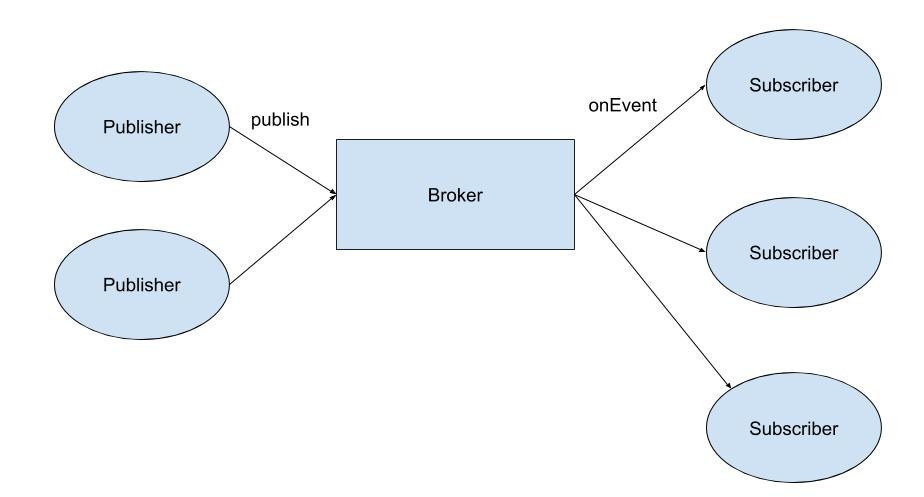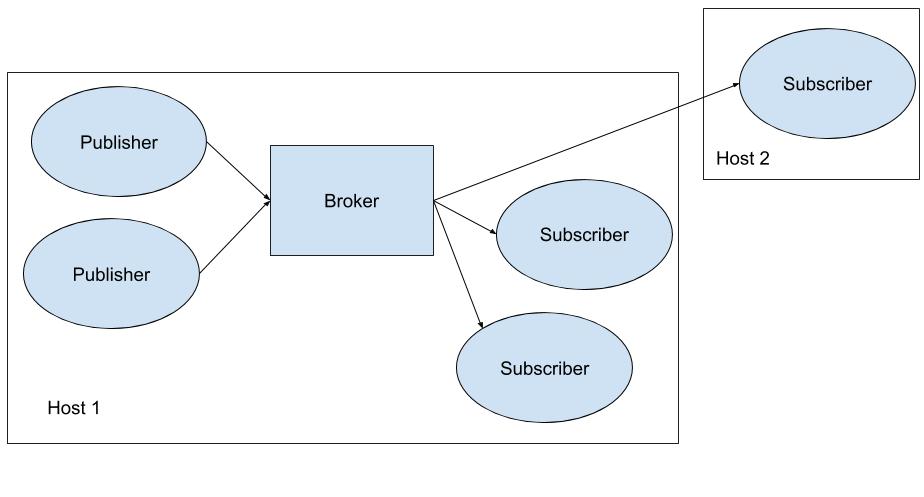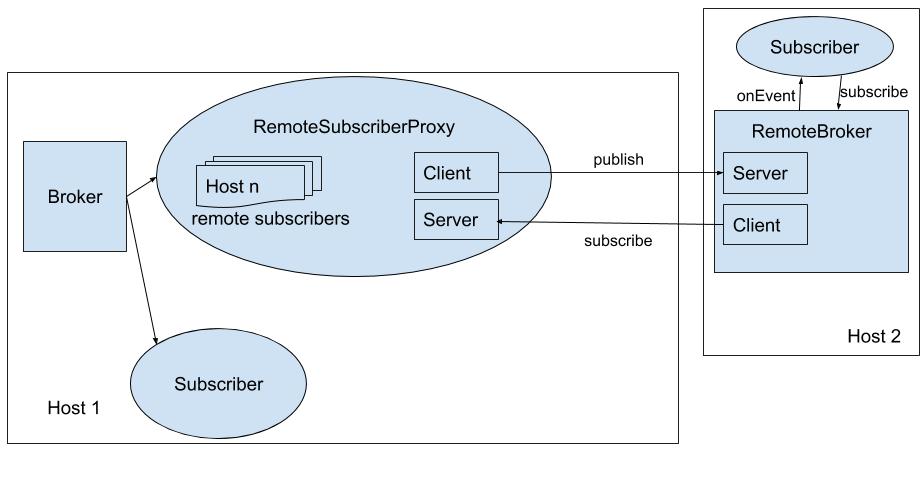For this project, I have implemented a message broker framework that will support publish/subscribe functionality. I have used following:
- Concurrency and threads
- Sockets
- Java Generics
- Good design practices
This Project has two parts:
- Part 1 (95%) - Part 1 implements a program that will run as a single Java process on one host.
- Part 2 (5%) - Part 2 implements a program that will allow a
Subscriberto be executed on a remote host. This requires implementing client/server functionality as part of solution.
I have implemented a framework with the following architecture:
Any number of publishers may publish data by calling the method publish on the Broker. Any number of subscribers may subscribe, and the Broker will deliver each message to all subscribers via the onEvent method.
I have implemented the following interface for the Broker.
public interface Broker<T> {
/**
* Called by a publisher to publish a new item. The
* item will be delivered to all current subscribers.
*
* @param item
*/
public void publish(T item);
/**
* Called once by each subscriber. Subscriber will be
* registered and receive notification of all future
* published items.
*
* @param subscriber
*/
public void subscribe(Subscriber<T> subscriber);
/**
* Indicates this broker should stop accepting new
* items to be published and shut down all threads.
* The method will block until all items that have been
* published have been delivered to all subscribers.
*/
public void shutdown();
}The following three concrete Broker implementations implements this interface.
The SynchronousOrderedDispatchBroker has the following properties:
- Synchronous - A newly published item will be synchronously delivered to all subscribers. The
publishmethod will not return to the publisher until all subscribers have completed theonEventmethod. - Ordered - The
Brokerguarantees that items from different publishers may not interleave. If a publisher is delivering to subscribers the next publisher must block until the first has finished.
The AsyncOrderedDispatchBroker has the following properties:
- Asynchronous - A newly published item will be asynchronously delivered to all subscribers. The
publishmethod will return to the publisher immediately, and the item will be delivered to the subscribers after thepublishmethod completes. - Ordered - The
Brokerguarantees that items from different publishers will be delivered to each subscriber in the same order. If any subscriber receives item1 before item2 then all subscribers will receive item1 before item2.
Implementation idea
- Consider using a
BlockingQueueto queue new items as they are published. - Consider using one additional thread to deliver messages to subscribers in order.
The AsyncUnorderedDispatchBroker has the following properties:
- Asynchronous - A newly published item will be asynchronously delivered to all subscribers. The
publishmethod will return to the publisher immediately, and the item will be delivered to the subscribers after thepublishmethod completes. - Unordered - The
Brokermakes no guarantees about the order in which items are delivered to the subscribers.
Hints
- Consider using an instance of
ExecutorServiceto asynchronouslyexecutejobs to deliver items to subscribers.
The Subscriber interface is implemented as follows:
public interface Subscriber<T> {
/**
* Called by the Broker when a new item
* has been published.
* @param item
*/
public void onEvent(T item);
}The framework described above will be implemented such that it could support a variety of applications. A Broker could handle any type of item, which is why we have used Generics.
In this project, I have implemented an application that will re-sort the Amazon reviews data set. Currently, the data is sorted by type of product (i.e., cell phones, home and kitchen, etc). Your demonstration application will use the publish/subscribe framework to create two new .json files---one with old reviews and one with new reviews.
- You will implement at least two publishers.
- Each publisher must run in a separate thread.
- Each publisher will be responsible for one of the 5-core reviews files from the Amazon product data dataset. You may choose which files to use.
- The publisher will parse each review as a separate JSON object and publish the object as a single item.
- I have implemented two subscribers.
- All subscribers will receive all items. One subscriber will filter items and save to a file only the older reviews and the other will filter items and save to a file only the newer reviews.
- I am using a unix review time of 1362268800 to separate old and new. This yields roughly 774,000 new reviews and 529,000 old reviews using the data sets recommended above.
- I am using this test application to compare the performance of the three
Brokerimplementations.
The only external libraries that are used for this assignment are GSON 2.8.5 and JUnit.
- Host 1 will need to implement a server that allows a remote subscriber to send a registration message.
- When a remote subscriber is executed, it will connect to the registration server.
- When a new item is published it will be forwarded from Host 1 to Host 2, then delivered to the subscriber.
- There are lots of ways to design a solution, however it is recommended that you modify the part 1 solution as little as possible. I have done this by implementing a
RemoteSubscriberProxythat behaves like a normalSubscriberto theBrokeron Host 1 but implements a server to accept connections from Host 2 and a client to forward items to Host 2. On Host 2, I implement aRemoteBrokerthat behaves like a normalBrokerto theSubscriberon Host 2 but proxies messages coming from theRemoteSubscriberProxy. The figure below shows this implementation, omitting detail of the original publishers.


